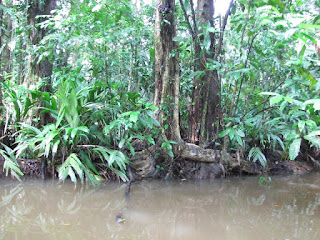

Flying towards Tortuguera, one of the largest wildlife and tropical rainforest preserves in the world, you can see some of the sandy beaches that are very popular with tourists but we will be spending most of our time going up the river and into the jungle. The Figure 12.17 picture you see is one from a textbook I sometimes use and I thought it was a pretty sad picture that barely demonstrated the real range of biodiversity of plants and animals in the preserve.


There is a small village where we jump on our boat. The tour itself advertises itself as "ecotourism" which is tourism that tried to be sustainable and have the least amount of negative effects on the environment and people who live in the areas you are visiting. As you know, the tropics gets a ton of rainfall and thus the soils are often of poor quality because minerals are washed off and you can see how thick the water is with sediment. Also, check out how much those tree roots hold the shoreline in place. Often when there is deforestation you can have large areas washed out and homes and productive agricultural land destroyed.


One of the dilemmas of development is places want to have things like electricity which needs infrastructure to go through. Unfortunately the areas you need to cut for things like powerlines allow for invasive species from other ecosystems to come in and disrupt the native plants and animals. An example can be see here of bamboo which was brought in during colonialism because it is quick growing and a good sturdy wood for building things but because it grows so rapidly it overtakes lots of natural areas. Often there will be laws against cutting down trees as they want to preserve what few there are still but they will encourage the cutting down of something like bamboo which you probably know, comes from the entire other side of the planet so it is very much invasive.




Along the shoreline you can see some areas are washing out, especially if they have had trees cut or died and thus their roots rot and are unable to hold the ground in. This is where we launch from the boat, you can see some animals in the tree tops already.












Technically a jungle is defined as the thick area of vegetation right next to the river there as the only place that the sun goes all of the way to the ground is next to a waterway. When you are in the forest itself the canopy can be so thick and not much suns gets to the actual ground so it can be a little bare.






In figure 12.10 above you can see how indigenous populations could utilize how the trees can contain those soils for farming, the root systems you see in these pictures make a nice lattice.




Keep in mind I am in no way a professional photographer so I was not able to get the full range of plans and animals in pictures but these are still all pretty cute (see the alligator in the grass above?). You can see as we went downstream we came across some locals and you can tell it is the dry season because the water level is quite a bit down from the heights of the stilts under the house. These kinds of stilts holding up the houses above the water level are pretty common in this region, especially along the river. You can also see lots of houses that are actually floating on the river which is even better at managing the ups and downs of the water levels.















No comments:
Post a Comment